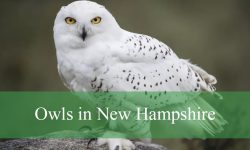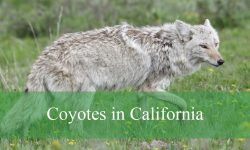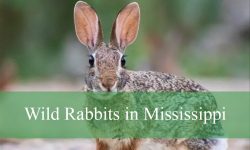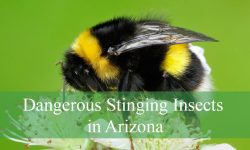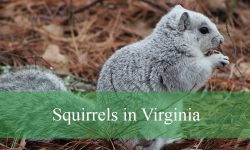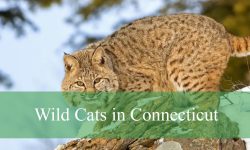Connecticut is home to many beautiful backyard birds that can be seen all year round. These birds add color and life to gardens, parks, and neighborhoods across the state. From bright songbirds to quiet visitors, there’s always something interesting to spot outside.
This article introduces 40 common backyard birds in Connecticut. Each bird is shown with pictures and simple identification tips to help you recognize them easily. You’ll learn about their colors, behaviors, and where to find them.
Birdwatching in your own backyard can be a fun and relaxing way to connect with nature. With a little attention and patience, you can discover a wide variety of birds right outside your door. Let’s explore these wonderful feathered friends together!
Common Backyard Birds Found in Connecticut
Blue Jay
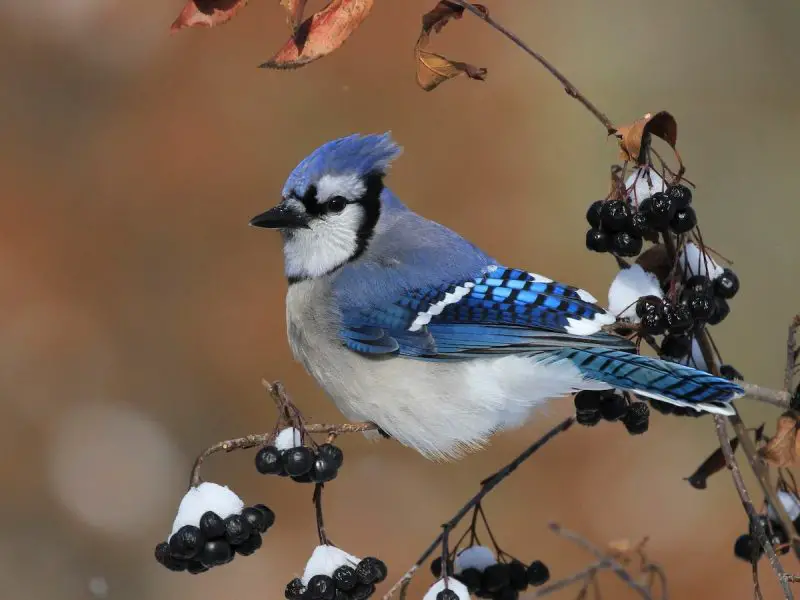
The Blue Jay is one of Connecticut’s most vibrant and vocal backyard birds, easily identifiable by its bright blue upperparts, white underparts, and bold black markings on the face and wings. It has a prominent crest that it raises and lowers depending on its mood, making it quite expressive and animated in appearance.
This bird measures about 9 to 12 inches in length with a wingspan of 13 to 17 inches. Blue Jays are extremely intelligent and have a varied vocabulary of calls, including mimicry of hawks to scare off other birds. Their most common call is a loud “jay! jay!” They are known for their clever problem-solving and strong family bonds, often traveling in tight-knit groups.
Blue Jays are common across Connecticut’s forests, woodlots, and suburban backyards. They are regular visitors to feeders, particularly fond of peanuts, sunflower seeds, and corn. These birds also cache food for later consumption, and their behavior can sometimes dominate feeders. Despite their bold nature, they play a crucial role in forest regeneration by spreading seeds.
Northern Cardinal
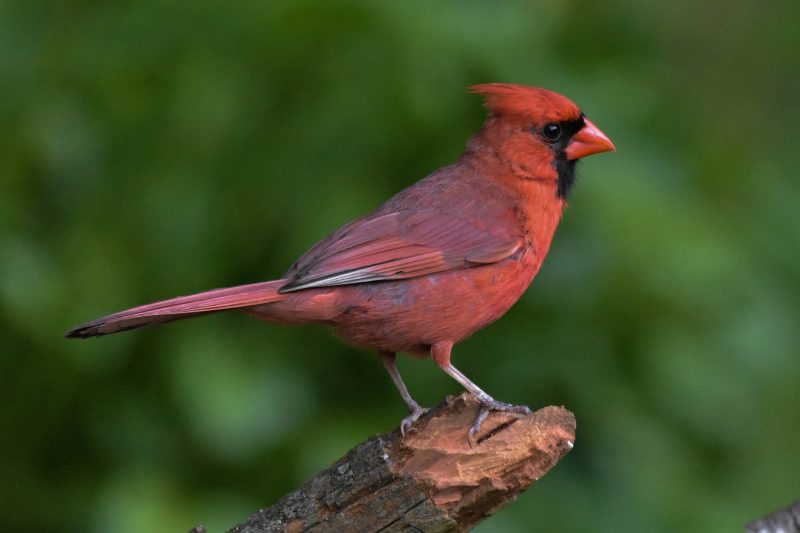
The Northern Cardinal is a striking bird that adds a vivid splash of color to Connecticut’s landscapes, especially in the winter months. Males are bright crimson red with a black mask around the beak, while females are a warm, muted brown with hints of red on the wings, tail, and crest. Both sexes have a prominent crest and a thick, orange-red beak that helps them crack open seeds.
This bird typically measures around 8 to 9 inches in length with a wingspan of about 10 to 12 inches. Its song consists of clear, whistled phrases that sound like “cheer, cheer, cheer” or “birdie, birdie, birdie.” Northern Cardinals are monogamous and often mate for life, frequently seen in pairs throughout the year. They do not migrate and can be spotted even during snowy winters.
In Connecticut, Northern Cardinals thrive in residential areas, woodlands, thickets, and forest edges. They readily visit backyard feeders, especially for black oil sunflower seeds, safflower, and cracked corn. They also forage on the ground for insects, fruits, and seeds, making them a regular and delightful visitor to suburban gardens.
American Robin
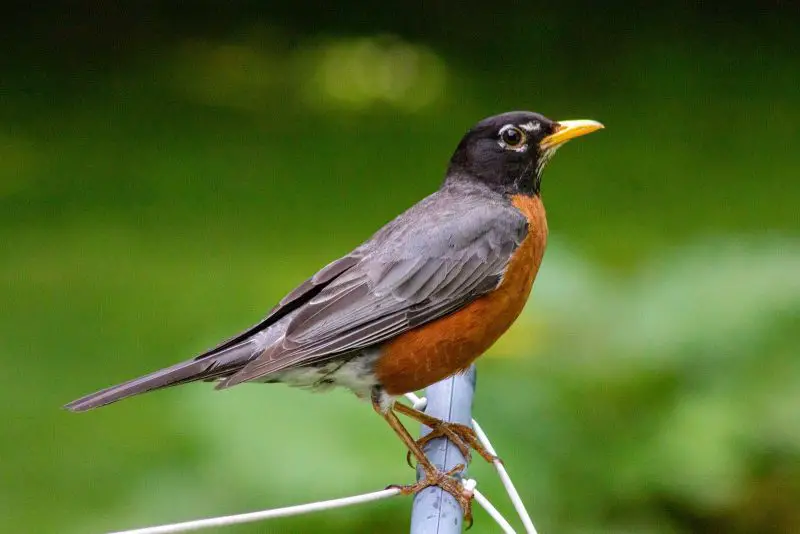
The American Robin is one of the most familiar and widely recognized birds across Connecticut, and it holds the title of the state bird. These birds are medium-sized with a distinctive orange-red breast, gray-brown back, and yellow bill. Their upright posture and confident movements make them easy to spot while foraging on lawns.
Robins measure about 10 inches in length and have a wingspan of roughly 14 to 16 inches. Known for their cheerful, melodious song, they are one of the first birds to sing at dawn. Their “cheerily, cheer-up” call is often associated with the arrival of spring. These birds are ground foragers and frequently seen hopping around grassy areas in search of worms and insects.
In Connecticut, American Robins are year-round residents, although some northern populations may migrate south during harsher winters. They are found in a variety of habitats, including backyards, parks, open fields, and forests. While they occasionally visit feeders for berries and mealworms, they are more often seen hunting natural prey in open grassy spaces.
Black-capped Chickadee
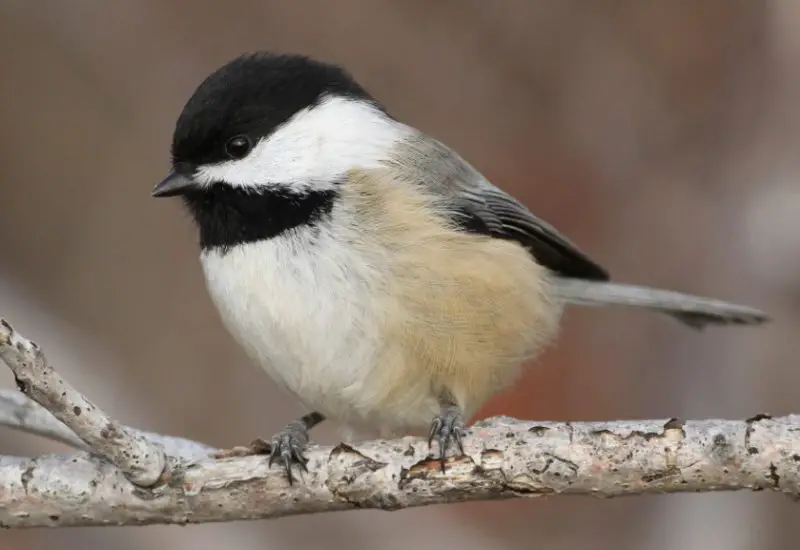
The Black-capped Chickadee is a small, energetic bird that brings personality and charm to Connecticut’s birdlife. Easily recognized by its black cap and bib, white cheeks, and soft gray wings and back, this bird has a short neck and a large head, giving it a distinctive, round appearance.
Chickadees are only about 5 to 6 inches long with a wingspan of 6 to 8 inches, but they’re bold and inquisitive. They are known for their namesake call—“chick-a-dee-dee-dee”—which increases in intensity when alarmed. These birds often form flocks in the fall and winter and will readily approach humans for food, especially when offered sunflower seeds or suet.
They are very common across Connecticut in woodlands, residential areas, and parks. During colder months, they cache food in bark and crevices, showing impressive memory for retrieval. Black-capped Chickadees are frequent visitors to backyard feeders and are among the first birds to arrive when new food is put out.
Tufted Titmouse
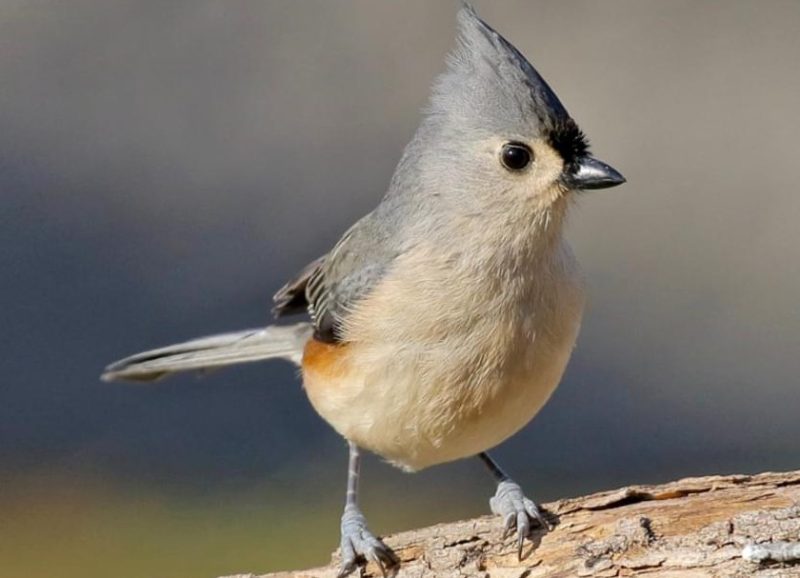
The Tufted Titmouse is a sleek, medium-sized songbird with soft gray plumage, a pale belly, rust-colored flanks, and a distinct pointed crest. Its expressive, oversized black eyes give it a curious and intelligent look. Like the chickadee, it belongs to the same Paridae family and often joins mixed feeding flocks.
Typically measuring about 5.5 to 6.5 inches long with a wingspan of around 8 to 10 inches, the Tufted Titmouse is known for its clear, whistled “peter-peter-peter” song. These birds are acrobatic foragers, often seen hanging upside down on branches while looking for insects, seeds, and nuts. They can be somewhat shy but become more visible at feeders.
In Connecticut, they are found year-round in deciduous and mixed forests, as well as suburban neighborhoods with mature trees. They frequently visit feeders for sunflower seeds, suet, and shelled peanuts. Their social behavior includes joining chickadees and nuthatches in winter flocks, making them an engaging part of the backyard birdwatching experience.
Mourning Dove
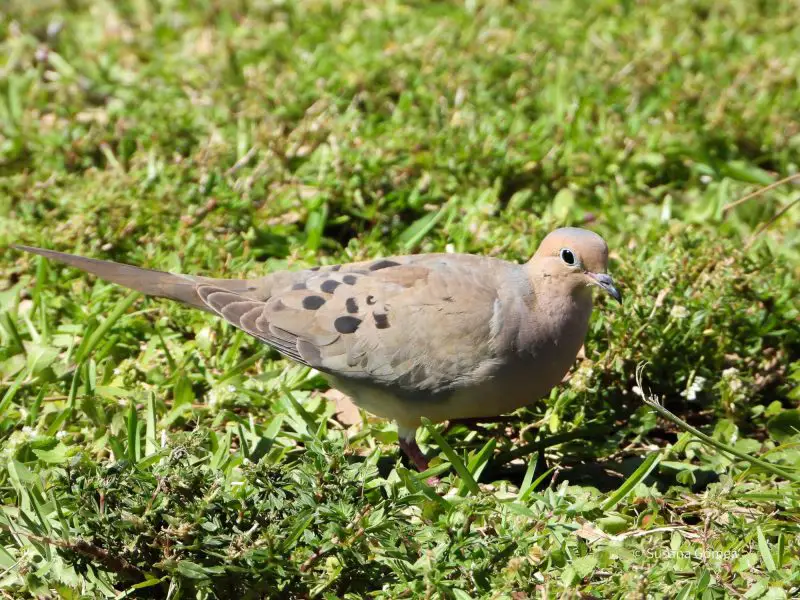
The Mourning Dove is a graceful, medium-sized bird with soft grayish-tan plumage, a slender tail edged in white, and small black spots on the wings. Its gentle appearance is matched by its soft, melancholic cooing call, which has earned it the name “mourning” dove. When in flight, they make a distinctive whistling sound with their wings.
Measuring about 9 to 13 inches long with a wingspan of 17 to 18 inches, Mourning Doves have small heads, long pointed tails, and pinkish legs. They are often seen perched on telephone wires, rooftops, or tree branches, and are known for their calm and docile behavior. Unlike many songbirds, they feed mostly on the ground, where they walk in smooth, graceful strides in search of seeds.
In Connecticut, Mourning Doves are widespread year-round and adapt well to suburban and rural environments. They frequent open fields, farmlands, gardens, and backyards. At feeders, they prefer to forage on platform feeders or the ground beneath hanging feeders, consuming millet, cracked corn, and sunflower seeds. Their gentle nature and soothing calls make them a peaceful addition to backyard bird scenes.
Downy Woodpecker
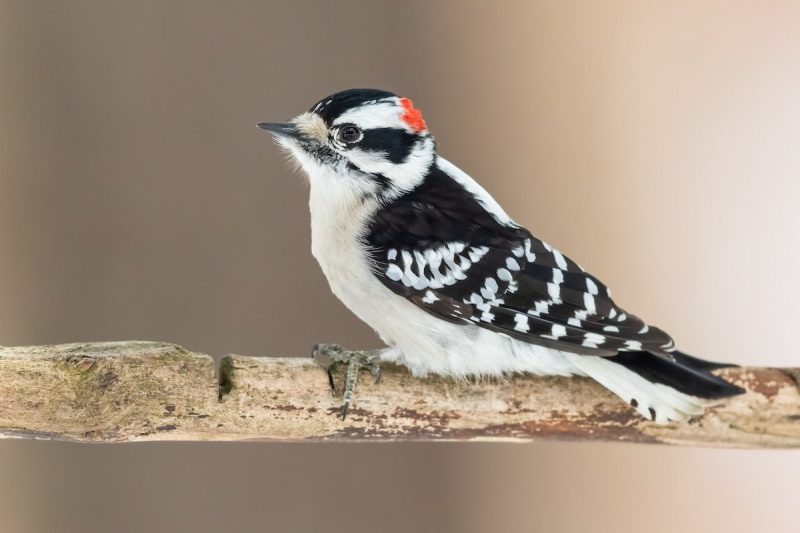
The Downy Woodpecker is the smallest woodpecker species in Connecticut, easily recognized by its bold black-and-white coloration. Males feature a small red patch on the back of their heads, while both sexes have white undersides, black wings with white spots, and a broad white stripe down the back. They have a short bill compared to larger woodpeckers.
This bird is about 5.5 to 6.7 inches long with a wingspan of 10 to 12 inches. Downy Woodpeckers are agile climbers, using their stiff tail feathers and sharp claws to cling to tree trunks and branches. Their drumming on wood, though softer than that of larger species, is a common sound in wooded areas. They also emit sharp “pik” calls and soft whinnies.
Downy Woodpeckers are year-round residents across Connecticut and frequently visit suet feeders, especially in winter. They thrive in deciduous forests, orchards, parks, and suburban yards with mature trees. Their diet consists of insects, especially larvae, as well as seeds and berries. Their small size and calm demeanor make them one of the most approachable woodpeckers for backyard birdwatchers.
White-breasted Nuthatch
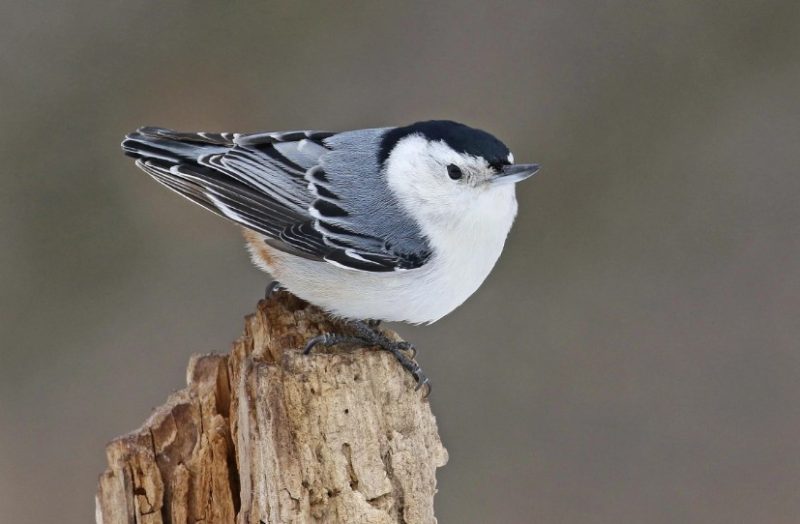
The White-breasted Nuthatch is a compact, energetic bird with a striking appearance—white face and underparts, a black cap, and a blue-gray back. Its sturdy body and sharp bill make it well-suited for probing into bark crevices, while its short tail and strong toes help it cling to vertical surfaces.
Typically measuring 5 to 6 inches in length with a wingspan of 8 to 10 inches, this bird is easily spotted by its unique behavior: climbing down tree trunks headfirst. White-breasted Nuthatches are known for their nasal “yank-yank” calls and rapid, jerky movements. They’re quite territorial and often pair for life, with mates staying together year-round.
In Connecticut, these birds are non-migratory and frequently seen in mature deciduous forests, wooded suburban areas, and even city parks. They readily visit feeders for sunflower seeds, suet, and peanuts. White-breasted Nuthatches often cache food in tree bark to eat later, showing impressive memory. Their acrobatics and bold foraging style make them a favorite among backyard birders.
House Finch
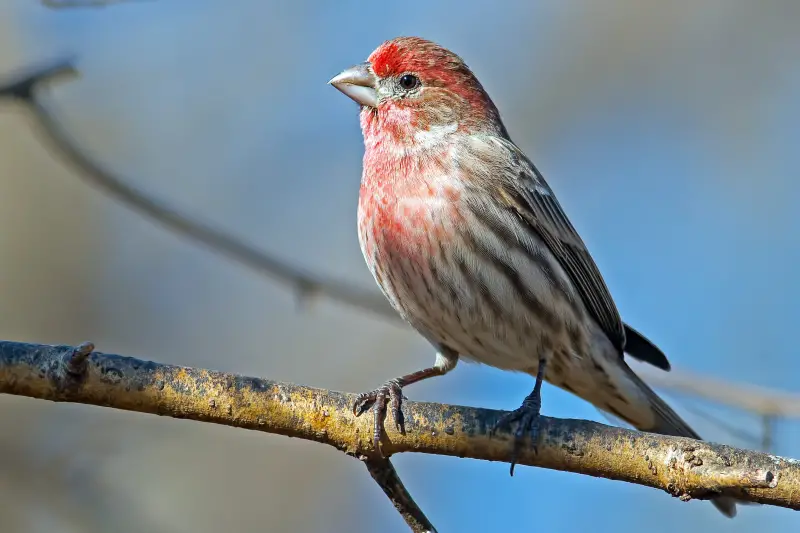
The House Finch is a small, social songbird with a cheerful personality and colorful appearance. Males are recognized by their rosy-red foreheads, throats, and chests, with brown-streaked backs and flanks. Females lack the red and are more subtly patterned with streaky brown and gray.
House Finches measure about 5 to 6 inches in length with a wingspan of 8 to 10 inches. Their songs are a jumble of chirps, warbles, and tweets that brighten up any backyard. These birds are gregarious and often found in small flocks. Originally native to the western U.S., they have successfully expanded their range and now thrive throughout Connecticut.
They are one of the most common visitors to bird feeders across the state, favoring black oil sunflower seeds, millet, and nyjer seed. House Finches adapt well to human environments and nest in building crevices, hanging planters, or tree branches. Their adaptability and lively behavior make them a familiar and welcome presence in residential areas.
American Goldfinch
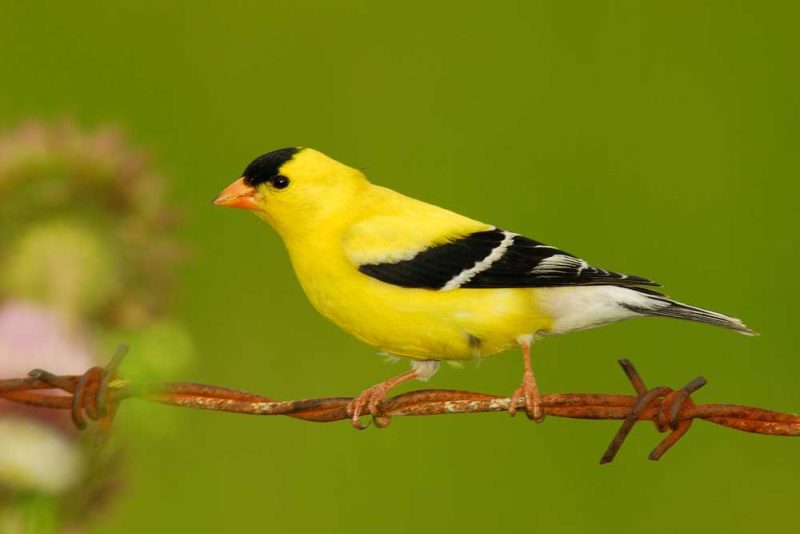
The American Goldfinch is a small, vibrant songbird with seasonal color changes that add dynamic beauty to Connecticut’s backyards. Males are bright lemon-yellow with black caps, wings, and tails during the summer breeding season, while females are a duller yellowish-brown. In winter, both sexes transition to a muted olive-brown tone.
These birds are around 4.5 to 5 inches long with a wingspan of 7.5 to 9 inches. Goldfinches have a bouncy, undulating flight pattern and a cheerful, twittering call often described as “per-chick-o-ree.” Their flight style and bright coloration make them easy to identify even from a distance. Males use their vivid plumage and sweet song to attract mates during spring and summer.
American Goldfinches are common throughout Connecticut and are especially fond of open fields, weedy meadows, and backyard gardens. They are strict vegetarians, primarily eating seeds from sunflowers, thistles, dandelions, and coneflowers. At feeders, they are drawn to nyjer (thistle) seed and sunflower chips. These birds nest later in the season than most, timing reproduction to coincide with the peak seed abundance in mid to late summer.
Carolina Wren
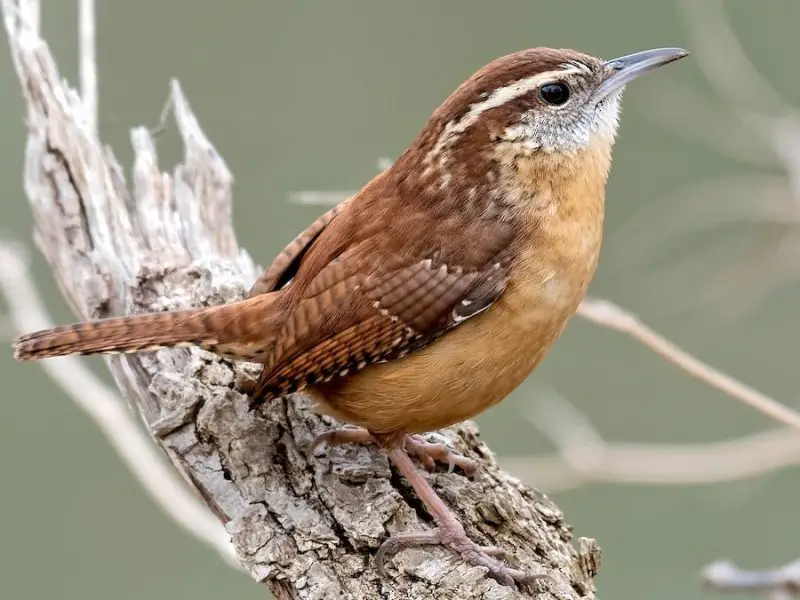
The Carolina Wren is a small, chunky songbird with a warm reddish-brown back, buffy-orange underparts, and a bold white eyebrow stripe that helps distinguish it from other wrens. Its slightly curved bill and upright tail, often cocked above the back, give it a confident and lively appearance. Though not large in size, this bird’s voice is anything but small.
Measuring about 4.7 to 5.5 inches in length with a wingspan of 11 inches, Carolina Wrens are often heard before they’re seen. Their song is a loud, rolling series of whistled notes—often interpreted as “teakettle-teakettle-teakettle!” They also produce various trills, chatters, and sharp chips. Males sing throughout the year and may continue even in the dead of winter.
In Connecticut, Carolina Wrens are becoming more common year-round due to milder winters. They prefer dense shrubs, woodpiles, and tangled vines in both suburban and forested settings. While not regular feeder birds, they will visit for suet, mealworms, and peanut butter, especially in cold weather. Their curious nature and powerful voices make them a hidden gem in backyard birdwatching.
Red-bellied Woodpecker
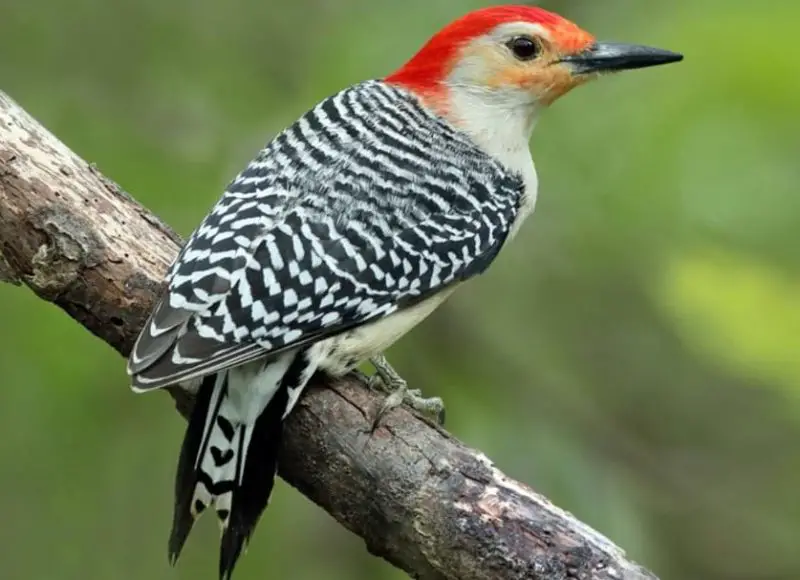
The Red-bellied Woodpecker is a medium-sized, eye-catching bird despite its slightly misleading name. The “red belly” is often faint and hard to spot, but the bird’s vibrant red crown (extending from the beak to the nape in males, and only the nape in females) is more prominent. Its black-and-white zebra-striped back makes it easily recognizable as it climbs up tree trunks.
This woodpecker measures about 9 to 10.5 inches long with a wingspan of 13 to 17 inches. It has a long, chisel-like bill and a strong, undulating flight. Red-bellied Woodpeckers have a rolling “churr” call and frequently drum on trees, poles, and even metal to communicate or establish territory. Their vocalizations and tapping make them easy to detect, even if they’re hidden in the trees.
In Connecticut, they are year-round residents and increasingly common in suburban areas with mature trees. They visit feeders for suet, sunflower seeds, peanuts, and fruit. Red-bellied Woodpeckers are also adept at catching insects from bark crevices and will store food in tree crevices for later consumption. Their vibrant appearance and active habits make them a dynamic presence in any backyard.
Song Sparrow
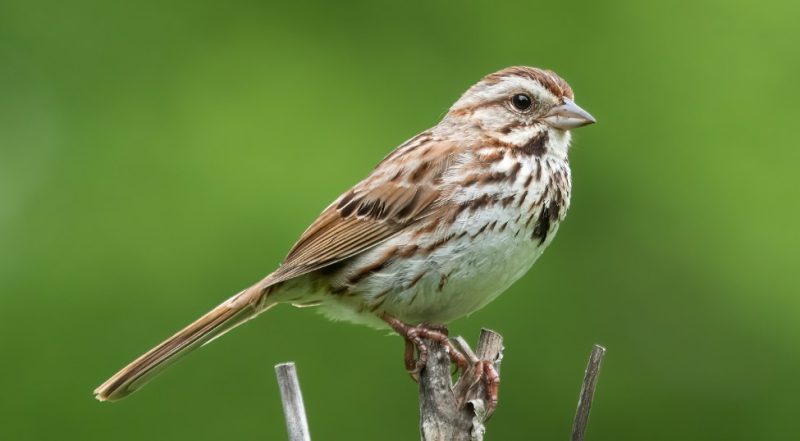
The Song Sparrow is a medium-sized, streaky brown bird with a white breast marked by thick brown streaks that often converge into a central spot. Its head may show gray and brown tones with a pale eyebrow stripe. Though modest in appearance, this sparrow has a beautiful and complex song that varies across individuals and regions.
This bird measures about 5.5 to 7 inches long with a wingspan of 7 to 9 inches. Its song, usually heard from a perch or shrub, begins with a few clear notes followed by a lively trill and a jumble of musical phrases. Song Sparrows are generally solitary or found in loose flocks. They feed on seeds and insects, often scratching at the ground with both feet.
In Connecticut, Song Sparrows are found year-round, though numbers increase in spring and summer with migrating populations. They inhabit open areas with low shrubs, marsh edges, gardens, and woodland edges. These sparrows visit feeders for millet and sunflower seeds but are more often seen foraging near dense cover. Their rich songs and adaptable nature make them a cherished part of the local birdlife.
Dark-eyed Junco
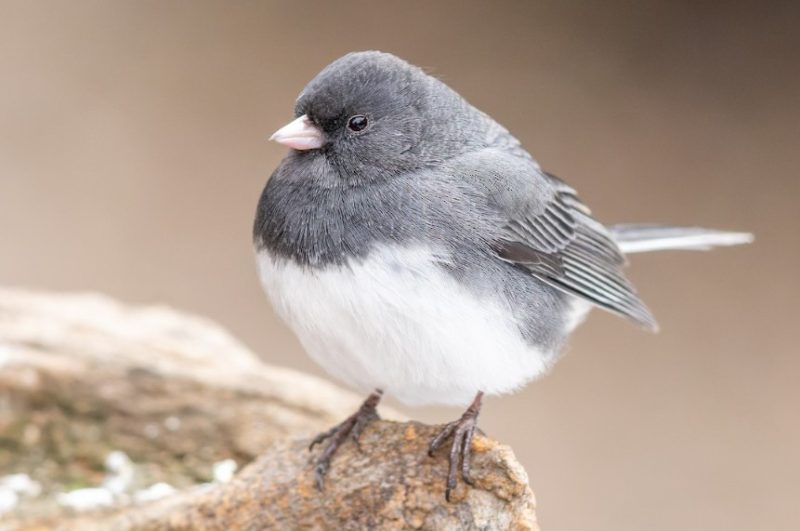
The Dark-eyed Junco is a wintertime favorite in Connecticut, often referred to as a “snowbird” due to its arrival with the colder months. These sparrows have slate-gray upperparts (or brownish in some females and juveniles) with crisp white bellies and outer tail feathers that flash in flight. Their small pink bill and rounded body give them a gentle look.
Juncos are about 5 to 6.5 inches long with a wingspan of 7 to 9 inches. They feed primarily on the ground, often in small flocks, hopping and scratching for seeds in leaf litter or snow. Their calls include short chips and metallic “tiks,” and their song is a simple, sweet trill that rises and falls slightly. They’re most active in the mornings and late afternoons.
In Connecticut, Dark-eyed Juncos are typically seen from fall through early spring. They prefer open woodland edges, parks, and suburban yards. At feeders, they favor millet, cracked corn, and sunflower seeds scattered on the ground or placed on platform feeders. Their sudden appearance in backyards is often seen as a sign that winter has officially arrived.
Eastern Bluebird
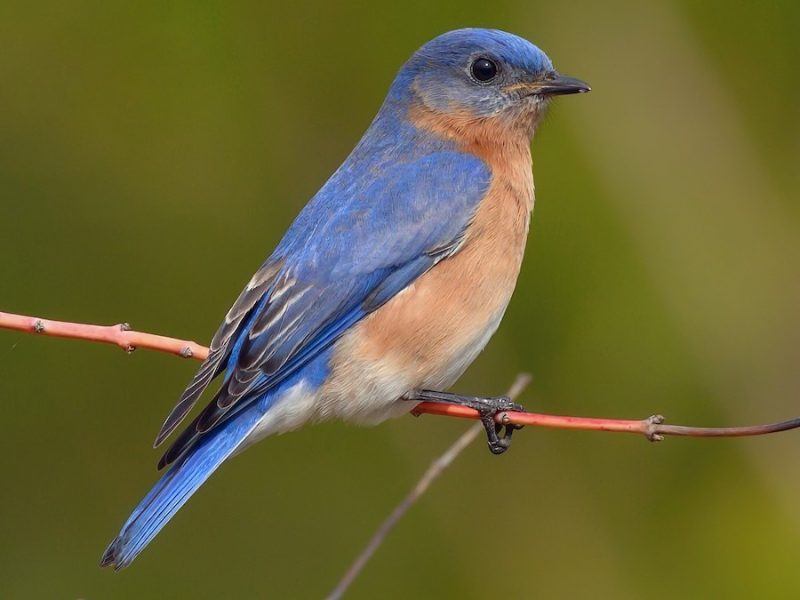
The Eastern Bluebird is one of Connecticut’s most beloved backyard birds, known for its vibrant coloring and gentle demeanor. Males are brilliant blue above with warm, rust-colored throats and chests, while females are softer gray-blue with pale orange on the breast. Their soft, rounded shape and alert posture give them a graceful, composed appearance.
These birds are about 6.5 to 7 inches in length with a wingspan of 9.5 to 12 inches. Eastern Bluebirds have a gentle, warbling song and soft, melodic calls that add a cheerful soundtrack to open landscapes. They are cavity-nesters and readily use man-made nest boxes, especially in yards with open lawns or meadows and scattered trees.
In Connecticut, Eastern Bluebirds are year-round in some parts of the state, particularly where nesting boxes are provided. They favor open fields, golf courses, orchards, and rural backyards. Though not common at traditional seed feeders, they are drawn to mealworms, berries, and suet. Their vibrant color and friendly behavior make them a favorite among birdwatchers and gardeners alike.
House Sparrow
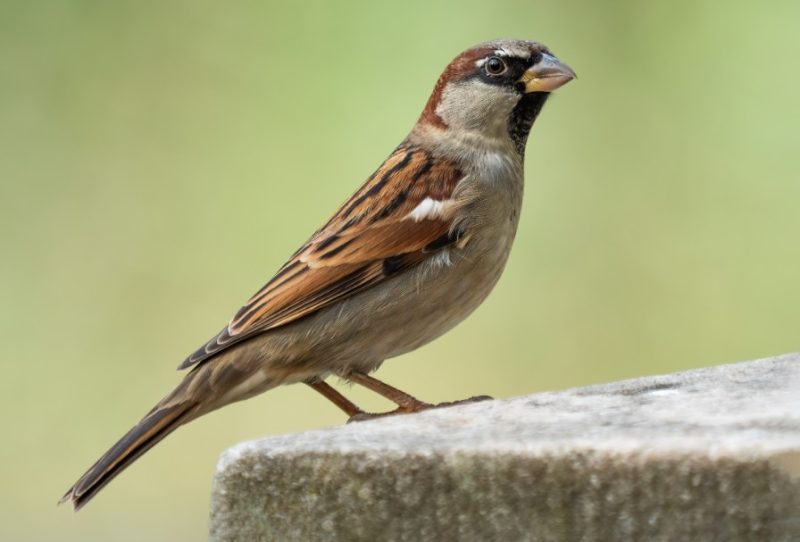
The House Sparrow is a small, stocky bird with a short tail and thick beak, often seen in bustling human environments. Males have gray crowns, chestnut napes, black bibs, and gray underparts, while females and juveniles are duller with plain brown and gray tones. Though not native to North America, this species has become one of the most widespread urban birds.
House Sparrows measure about 5.5 to 6.5 inches in length with a wingspan of 7.5 to 9.8 inches. They produce constant, chattering “chirps” and are very social, often gathering in large flocks. Males can become aggressive around feeders and nesting areas, especially during the breeding season. They often nest in cavities or crevices in buildings, vents, or signs.
In Connecticut, House Sparrows are found year-round in cities, suburbs, and farms. They are regular visitors to backyard feeders, especially those offering cracked corn, millet, and sunflower seeds. Though sometimes seen as a nuisance due to their abundance and aggressive behavior, they are an integral part of many urban ecosystems and are easily observed up close.
European Starling
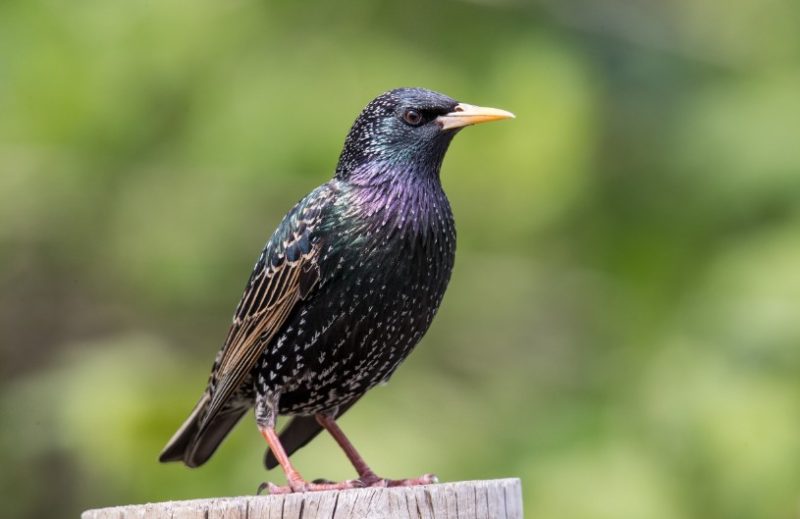
The European Starling is a medium-sized, glossy black bird with a short tail, long pointed bill, and triangular wings. In breeding season, their plumage shines with iridescent purples and greens, while in winter they display a dense pattern of white spots. They were introduced to North America in the 19th century and have since spread across the continent.
Starlings are about 7.5 to 9 inches long with a wingspan of 12 to 16 inches. Their vocalizations are a mix of whistles, clicks, and imitations, and they often gather in large, noisy flocks. In flight, they move in synchronized groups known as murmurations, creating breathtaking aerial displays. These birds are bold, adaptable, and opportunistic in their feeding habits.
In Connecticut, European Starlings are common year-round in urban areas, farmlands, and suburban neighborhoods. They forage on lawns for insects and worms but also frequent feeders for suet, bread scraps, and grains. Although considered invasive, they are remarkably intelligent and thrive in a wide range of environments, from city centers to open fields.
Gray Catbird
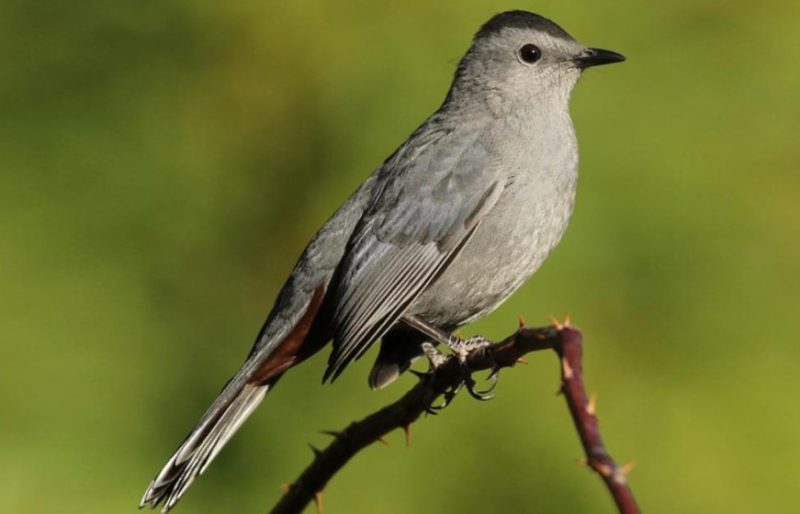
The Gray Catbird is a sleek songbird with soft, charcoal-gray plumage, a darker blackish cap, and a distinctive rusty patch under the tail. It gets its name from its unique “mewing” call that closely resembles a cat’s meow. This bird prefers to remain hidden in thickets and shrubs, making it more often heard than seen.
Gray Catbirds are around 8.5 to 9.5 inches long with a wingspan of 8.5 to 11.8 inches. They are exceptional mimics, capable of copying other bird songs, frogs, and even mechanical noises. Their song is a long, jumbled series of warbles, squeaks, and whistles. Unlike many mimics, they rarely repeat phrases and tend to sing in a rambling, unpredictable sequence.
In Connecticut, Catbirds are summer residents, returning in spring to breed. They prefer densely vegetated areas like forest edges, overgrown gardens, and backyard hedgerows. While not frequent feeder birds, they will occasionally visit for fruits, jelly, or mealworms. Their curious, vocal nature and preference for secluded areas make them an intriguing backyard presence.
Northern Mockingbird
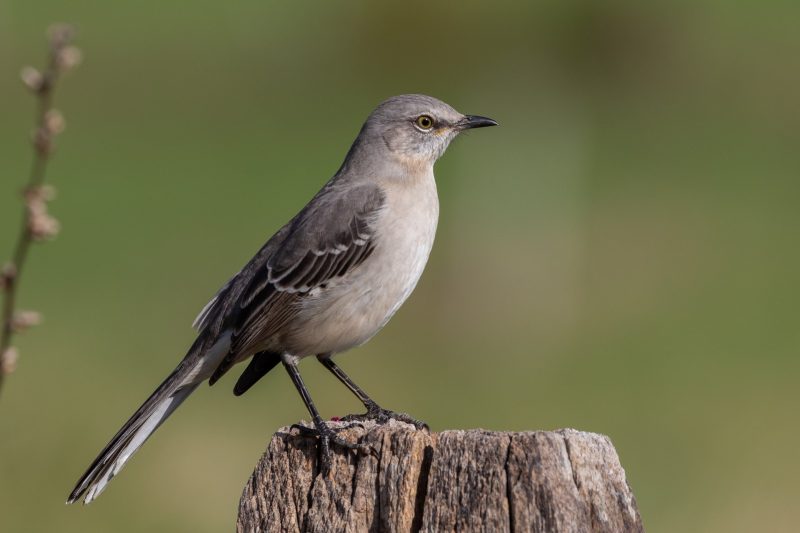
The Northern Mockingbird is a slender, long-legged bird with light gray plumage, a white belly, and bold white wing patches visible in flight. Its long tail and straight posture give it an alert and confident appearance. It is well-known for its unmatched vocal mimicry and territorial singing behavior.
This bird measures about 8 to 10 inches in length with a wingspan of 12 to 15 inches. Mockingbirds sing loudly and persistently, often mimicking the calls of other birds, insects, and even mechanical noises. Males may sing day and night during the spring breeding season, especially if they are unmated. Their performances often occur from prominent perches like trees, poles, or rooftops.
Northern Mockingbirds are year-round residents in Connecticut and are typically found in open habitats with scattered shrubs and trees. They are not frequent visitors to feeders, but they will come for raisins, suet, and fruit, especially during colder months. Their bold behavior and impressive vocal range make them standout characters in both rural and urban settings.
Baltimore Oriole
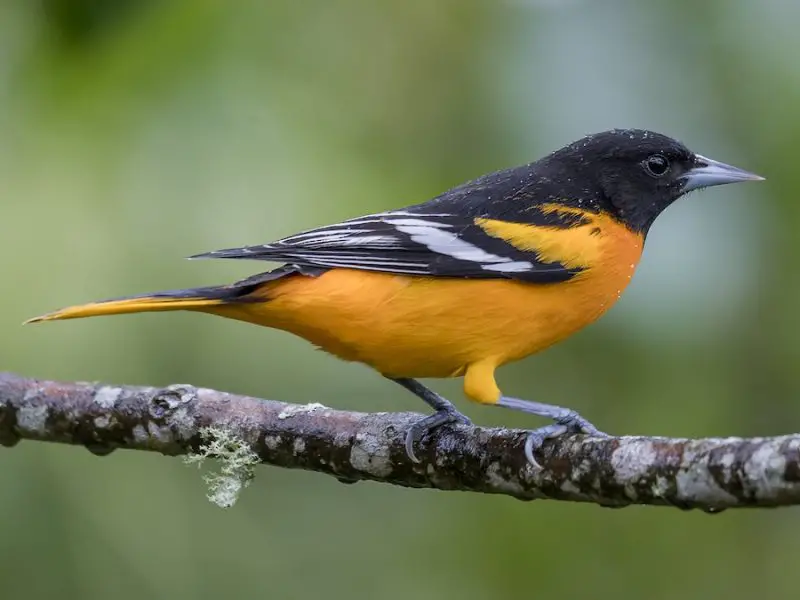
The Baltimore Oriole is one of the most strikingly beautiful birds in Connecticut, especially during spring and summer. Males are bright orange with black heads, backs, and wings trimmed in white, while females and juveniles are more muted with orange-yellow bodies and grayish wings. Their sleek, slender bodies and sharp bills make them elegant and agile.
Orioles are about 6.5 to 8 inches long with a wingspan of 9 to 12 inches. They sing a series of rich, whistling notes and also make harsh calls. Baltimore Orioles are migratory, arriving in Connecticut in late April or early May to breed, and departing by late summer. They often build hanging, sock-like nests in tall deciduous trees.
In backyards, Baltimore Orioles are especially attracted to sugary treats like orange halves, grape jelly, and nectar offered in specialized oriole feeders. They prefer open woodlands, edges, and suburban yards with mature trees. Though seasonal visitors, their vivid colors and musical songs bring excitement to the spring and summer garden landscape.
Ruby-throated Hummingbird
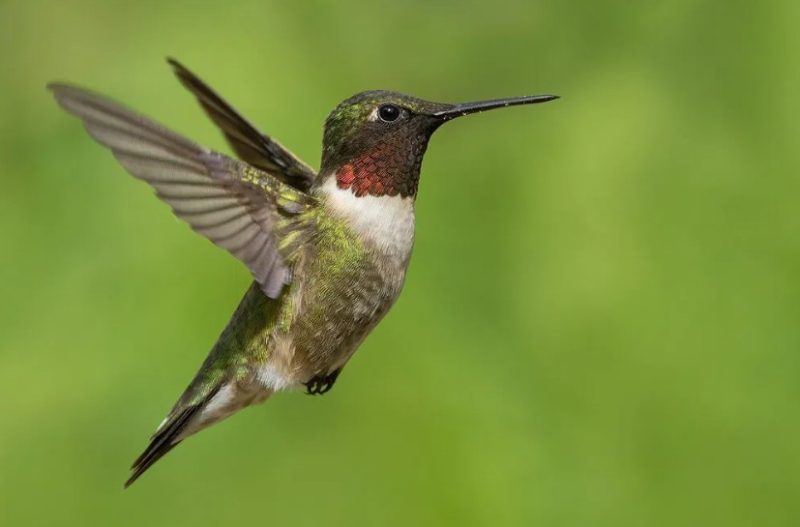
The Ruby-throated Hummingbird is the only hummingbird species commonly found in Connecticut. Males are easily recognized by their iridescent ruby-red throats, emerald green backs, and slender build, while females lack the red throat and have a more subdued green and white coloration. Both sexes are tiny and energetic, constantly darting through gardens and flower beds.
This hummingbird measures only about 3 to 3.5 inches in length with a wingspan of 4 to 4.5 inches. Their wings beat around 50 times per second, allowing them to hover and even fly backward. Their sharp chirps and the hum of their wings are often the first signs of their presence. Males are territorial and may chase other hummingbirds away from food sources.
Ruby-throated Hummingbirds migrate to Connecticut in late spring and leave by early fall. They favor open woodlands, flower gardens, and areas with tubular, nectar-rich blooms like bee balm, trumpet vine, and columbine. They are also drawn to sugar water feeders, which should be kept clean and filled with a 1:4 sugar-to-water solution. Their agility and beauty make them a highlight of summer birdwatching.
Chipping Sparrow
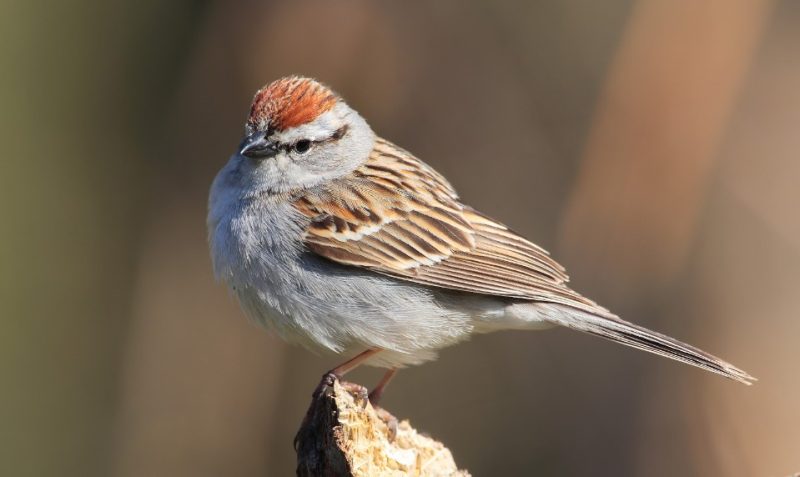
The Chipping Sparrow is a petite, elegant bird with a clean gray chest, a chestnut-red crown during breeding season, and a sharp black line through the eye. Outside the breeding season, its colors become more muted, but the neat, trim shape remains distinctive. Its simple appearance is paired with a crisp, dry trill of a song.
These sparrows measure about 4.5 to 5.5 inches in length and have a wingspan of 8 inches. They are typically seen hopping or running along the ground in search of seeds and small insects. Despite their small size, they can be quite social and are often found in flocks during migration or in wintering areas farther south.
In Connecticut, Chipping Sparrows are seasonal visitors, breeding throughout the state from spring through summer. They favor grassy areas, forest edges, and suburban lawns, especially those with scattered trees or shrubs. They occasionally visit feeders for small seeds like millet, but are more commonly seen foraging on the ground or perched on low shrubs.
Red-winged Blackbird
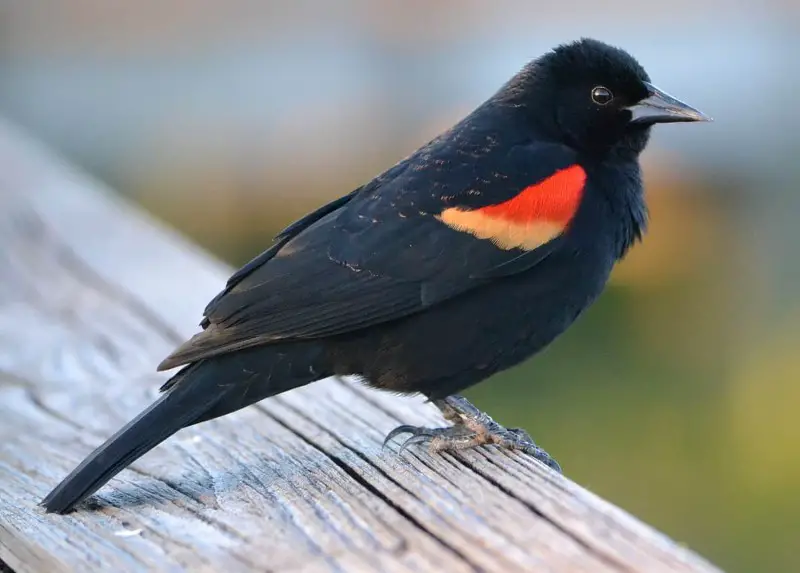
The Red-winged Blackbird is a familiar and striking sight in spring and summer. Males are a glossy black with vivid red and yellow shoulder patches, or “epaulettes,” which they display during singing and territorial behavior. Females are streaky brown and resemble large sparrows, often going unnoticed compared to the dramatic males.
These birds are about 7 to 9.5 inches long with a wingspan of 12 to 16 inches. Males perch on cattails, shrubs, or wires and sing a distinct “conk-la-ree!” song to declare territory. They are aggressive defenders of nesting areas and often dive at intruders, including humans, during the breeding season.
In Connecticut, Red-winged Blackbirds are widespread during spring and summer, especially around wetlands, marshes, and pond edges. While primarily marsh dwellers, they often venture into yards and fields in search of food, particularly in early spring. They forage for insects, seeds, and grains, and may visit feeders, especially platform ones offering sunflower or cracked corn.
Common Grackle
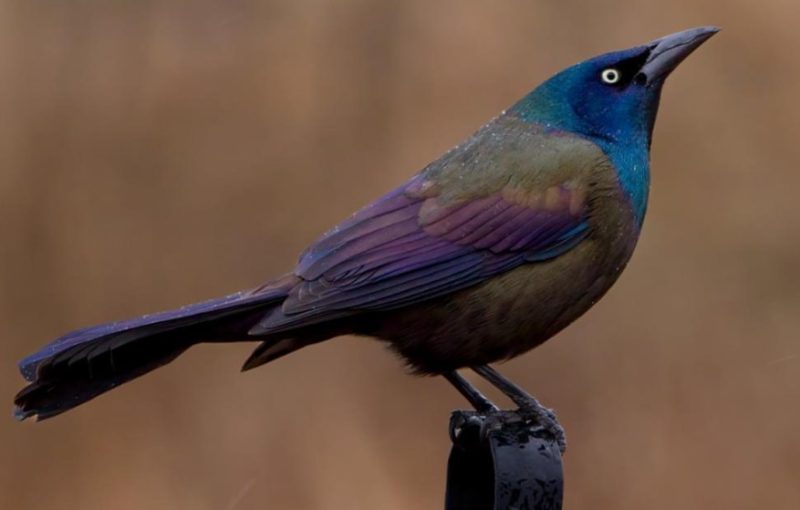
The Common Grackle is a large, long-legged blackbird with iridescent plumage that can appear blue, purple, or green in the right light. Its pale yellow eyes, long keel-shaped tail, and strong bill give it a distinctive, almost intimidating look. Though often overlooked, grackles are intelligent and adaptable birds.
They measure about 11 to 13 inches long with a wingspan of up to 18 inches, making them noticeably larger than most backyard birds. Their call is a loud, harsh screech or metallic-sounding whistle, often described as sounding like rusty hinges. Grackles are social and commonly seen in large flocks, especially outside of breeding season.
In Connecticut, they are common from spring through fall and often nest in tall trees near open areas or wetlands. They readily visit backyards for seeds, corn, and suet, but may also scavenge food from lawns and trash bins. Although sometimes seen as pests due to their flocking behavior and loud calls, they play an important role in controlling insect populations.
Brown-headed Cowbird
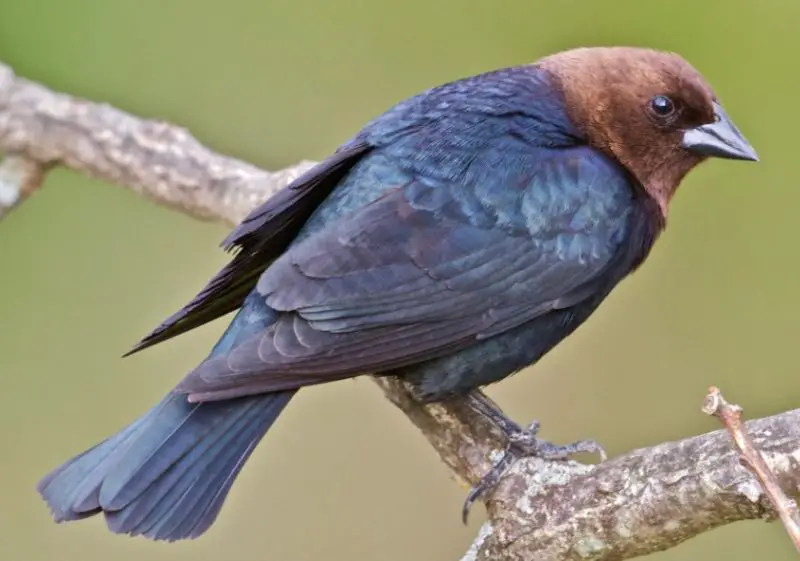
The Brown-headed Cowbird is a small blackbird known for its unusual and sometimes controversial nesting behavior. Males have glossy black bodies and rich brown heads, while females are plain gray-brown with faint streaking. They are slightly smaller and less bulky than grackles but share similar habits.
Cowbirds measure about 7.5 to 8.5 inches in length with a wingspan of 12 to 15 inches. Instead of building their own nests, females lay their eggs in the nests of other bird species, leaving the host parents to raise their young. This brood parasitism can negatively affect the host bird’s offspring, making cowbirds a subject of ecological concern.
In Connecticut, Brown-headed Cowbirds are common in open fields, pastures, forest edges, and residential areas during the warmer months. They forage on the ground for seeds and insects and will visit feeders for millet, sunflower, and cracked corn. Despite their controversial nesting strategy, cowbirds are fascinating to observe and add another layer to Connecticut’s diverse birdlife.
Cedar Waxwing
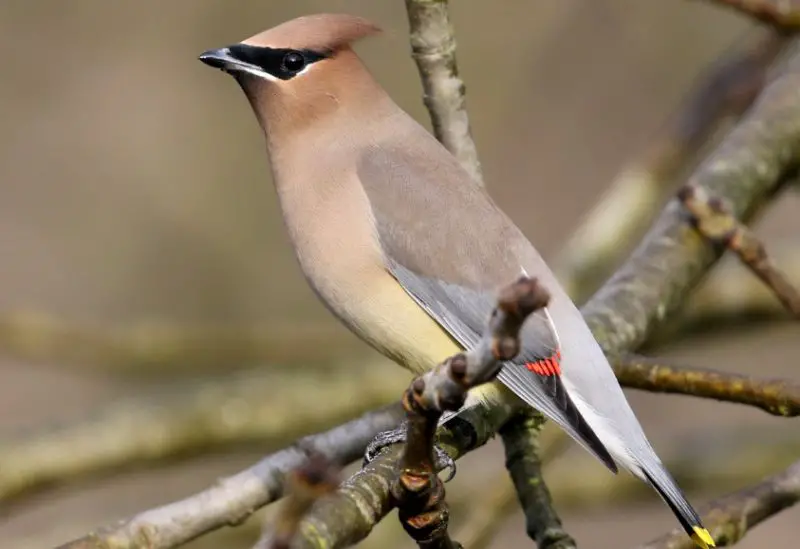
The Cedar Waxwing is one of the most elegant and smooth-looking songbirds in North America. It has silky brownish-yellow plumage, a sleek black mask edged in white, a soft crest, and a bright yellow tip on its tail. Some birds also have red waxy tips on their wing feathers, which give the species its name.
Cedar Waxwings measure about 6 to 7 inches long with a wingspan of 8.5 to 11 inches. Their calls are high-pitched, almost whistle-like “sseee” notes that are soft and lisping. These birds are highly social and often travel in tight, quiet flocks. Their calm and gentle behavior is quite different from the noisy habits of many other backyard birds.
In Connecticut, Cedar Waxwings are found year-round, although their numbers peak in late summer and fall when berry-producing plants are abundant. They favor fruit-bearing trees and shrubs like serviceberry, dogwood, holly, and juniper. They occasionally visit birdbaths and are more likely to appear in backyards that provide natural food sources rather than feeders. Their graceful presence and fondness for berries make them favorites for birdwatchers with native landscaping.
Blue-gray Gnatcatcher
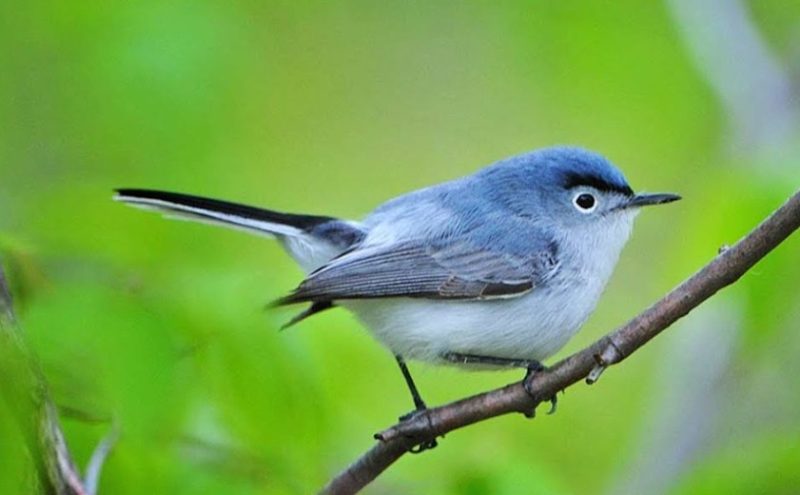
The Blue-gray Gnatcatcher is a tiny, active bird with soft blue-gray plumage, a long black-and-white tail, and a narrow, slightly curved bill. Its expressive white eye ring and quick, flicking movements make it resemble a miniature mockingbird. This bird is constantly in motion, searching for insects among leaves and branches.
Measuring just 4 to 5 inches in length with a wingspan of about 6 inches, this gnatcatcher emits a nasal, buzzy call that sounds like “zzzee” or “spee.” It frequently flicks its tail and hovers briefly as it picks off gnats, flies, and spiders from foliage. Their tiny nests, often made of lichen and spider silk, are expertly camouflaged in tree forks.
In Connecticut, Blue-gray Gnatcatchers are spring and summer residents, typically arriving in April and leaving by September. They prefer open woodlands, forest edges, and backyards with tall trees. Although they do not visit feeders, they are easy to spot in natural areas by their fidgety behavior and soft calls. They are particularly drawn to deciduous trees where insect life is abundant.
Purple Finch
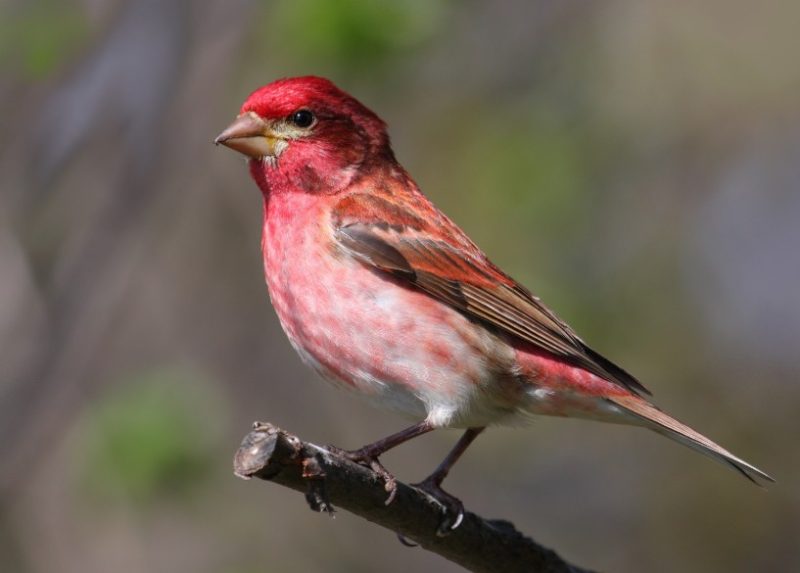
The Purple Finch is a sturdy, thick-billed finch with a rich raspberry-red coloration on the males that extends from the head through the chest, fading into lighter underparts. Females are streaked brown and white with bold facial markings, including a strong white eyebrow and mustache stripe. Their overall build is bulkier than that of the similar-looking House Finch.
Purple Finches are about 6 inches long with a wingspan of 8.5 to 10 inches. Males sing rich, warbling songs that include up-and-down phrases and mimicry. They often perch quietly in conifers or nearby shrubs and are not as aggressive at feeders as some other finches. These birds tend to be more nomadic and may appear in large numbers one winter and be scarce the next.
In Connecticut, Purple Finches are irregular winter visitors, more common in some years depending on food availability in the north. They are attracted to feeders offering black oil sunflower seeds, nyjer, and safflower. They also feed on buds, berries, and seeds in natural areas, especially in mixed forests and pine stands. Their beautiful plumage and pleasant songs make them a welcome guest during the colder months.
Pine Siskin
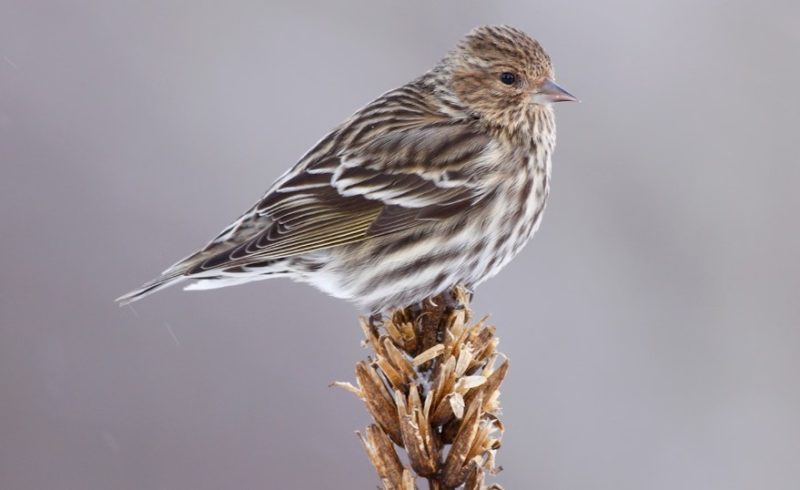
The Pine Siskin is a small, finely streaked brown bird with flashes of yellow on its wings and tail. Though similar in appearance to a female goldfinch, its sharply pointed bill, thin shape, and subtle yellow markings help distinguish it. These birds are often found in energetic, chattering flocks that suddenly appear and disappear in backyard feeders.
Pine Siskins measure about 4.5 to 5 inches in length with a wingspan of 7 to 8.5 inches. Their call is a distinctive, rising “zzzzzreee” or a buzzy trill, and their vocalizations are often the first sign of their presence. They are extremely social and may feed side-by-side with goldfinches and other small songbirds without hesitation.
In Connecticut, Pine Siskins are irruptive winter visitors, meaning their appearance varies year to year depending on seed crop availability farther north. They favor sunflower chips, nyjer seed, and the seeds of coniferous trees. These birds are particularly drawn to feeders in colder months and may arrive in large numbers when northern food supplies are scarce. Their sudden flocks and spirited energy are a joy to observe during winter.
Eastern Towhee
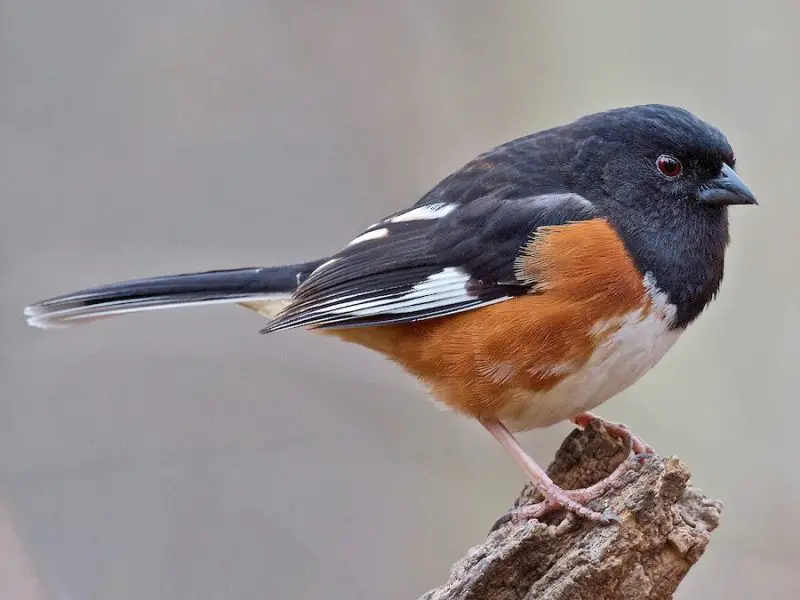
The Eastern Towhee is a striking ground-dwelling bird with bold black (male) or rich brown (female) upperparts, bright white bellies, and warm rufous sides. Their thick, conical bill and long tail help them dig through leaf litter in search of food. Towhees are shy but vocal, often remaining hidden in dense shrubs and brush.
Measuring around 7 to 8.5 inches long with a wingspan of 9 to 11 inches, Eastern Towhees are known for their distinctive song that sounds like “drink-your-tea!” or a sharp “chewink” call. They forage by hopping and kicking both feet backward to uncover seeds, insects, and small invertebrates on the forest floor.
In Connecticut, Eastern Towhees are mostly summer residents, though some may remain into fall or winter in southern parts of the state. They prefer shrubby woodlands, overgrown fields, and forest edges, but can be enticed into backyards with thick cover and leaf litter. Although they rarely visit feeders, they may forage under them for fallen seed. Their vivid appearance and unique behaviors make them a rewarding bird to spot.
Eastern Phoebe
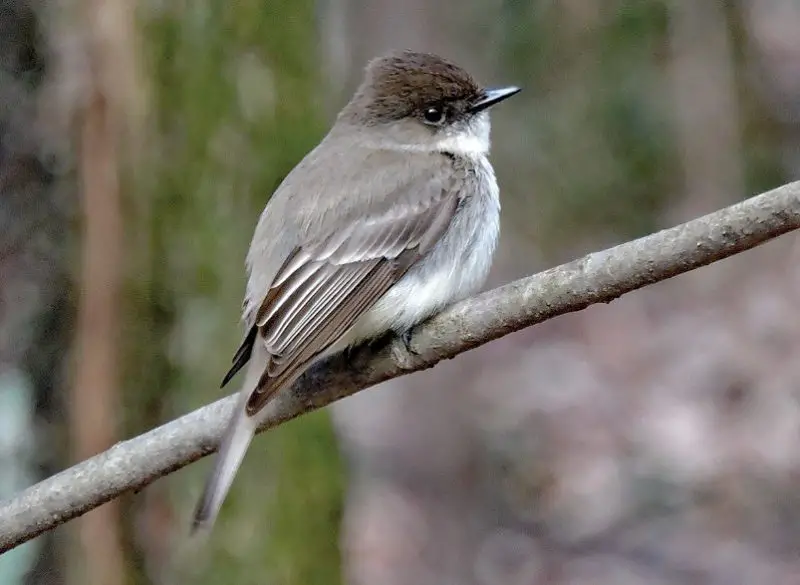
The Eastern Phoebe is a plain yet charming flycatcher with a grayish-brown back, whitish underparts, and a slight crest. It has a modest appearance compared to other songbirds, but its behavior is distinctive. One of its key identifying habits is constantly bobbing its tail while perched, giving it a nervous or watchful demeanor.
Measuring about 5.5 to 6.7 inches in length with a wingspan of 10 to 11 inches, the Eastern Phoebe is best known for its sharp, whistled call that sounds like “fee-bee,” often repeated continuously during the spring and early summer. It hunts by sitting on a low perch and darting out to catch insects in midair, then returning to the same perch repeatedly.
In Connecticut, Eastern Phoebes are among the earliest migrants to return in the spring, often arriving by March. They nest on ledges, bridge supports, porch eaves, or other sheltered human structures, using mud and moss to build their nests. Though they don’t visit feeders, they’re commonly seen around gardens, open woodlands, and barns where insects are plentiful.
Barn Swallow
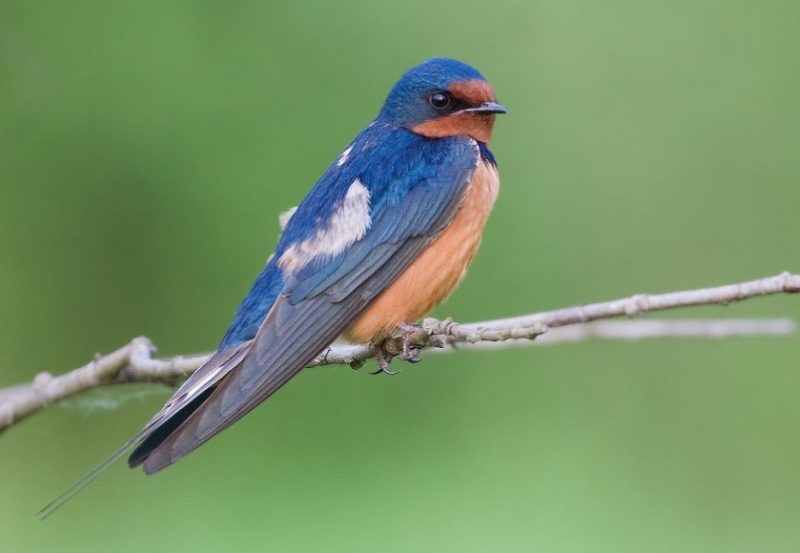
The Barn Swallow is a sleek, agile bird with a deeply forked tail and glossy blue-black upperparts. Its underparts are a rich, cinnamon-rust color, and it has a dark throat band that contrasts with its lighter belly. This species is renowned for its graceful flight and insect-catching prowess, often seen darting and swooping low over fields and ponds.
Barn Swallows are about 6.5 to 7 inches long with a wingspan of 11 to 12.5 inches. Their long, pointed wings and deeply forked tail help them maneuver quickly as they chase flying insects. Their song is a series of cheerful twitters and chirps, often heard as they call to one another in flight or near nesting sites.
In Connecticut, Barn Swallows are summer residents, nesting in barns, under eaves, or in sheds where mud nests can be attached to ledges. They prefer open areas such as fields, farms, and wetlands. While they do not visit feeders, their presence is a welcome sign of spring and early summer, especially in rural and semi-rural areas.
Tree Swallow
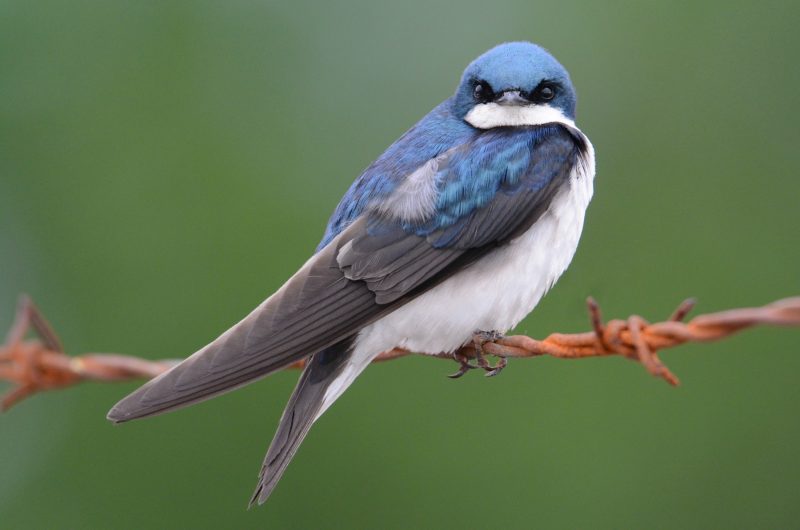
The Tree Swallow is a small, elegant bird with shimmering blue-green upperparts and crisp white underparts. It has a slightly notched tail and a smooth, streamlined body built for agile flight. Males are more vividly colored than females, but both sexes share the same basic sleek profile.
Tree Swallows measure about 5 to 6 inches long with a wingspan of 11 to 13 inches. Their calls are a series of bubbly, chirpy notes that sound like rapid “cheer-weet” or “twittering” trills. These birds feed almost entirely on flying insects, performing swooping flights over fields, ponds, and wetlands to catch prey on the wing.
In Connecticut, Tree Swallows are common during spring and summer, arriving as early as March. They readily use nest boxes placed in open fields or near water, especially if those boxes are spaced apart to reduce competition. Though they don’t visit feeders, they are welcomed by birders and gardeners who provide nesting sites. Their iridescent plumage and acrobatic flight make them a seasonal favorite.
Great Crested Flycatcher
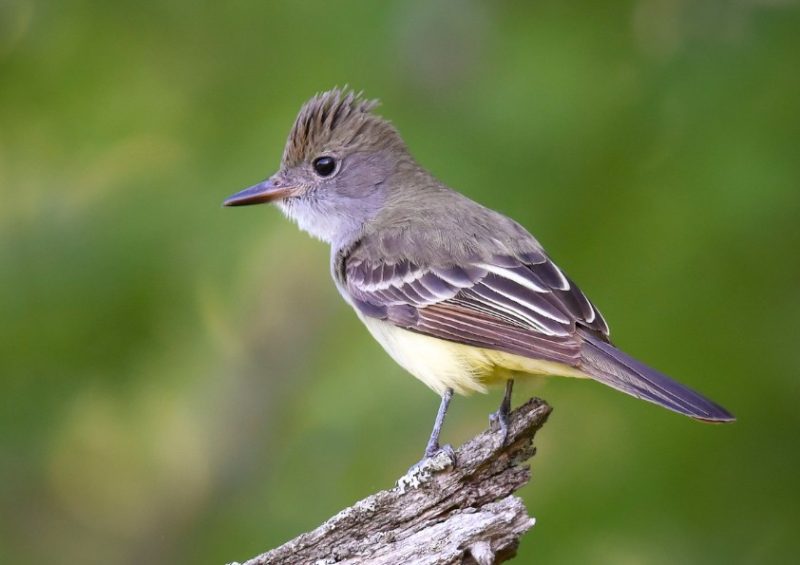
The Great Crested Flycatcher is a bold and striking member of the flycatcher family, easily recognized by its lemon-yellow belly, gray chest, and warm brown back. It has a thick bill, bushy crest, and rich reddish-brown tail and wings that give it a colorful and unique profile among woodland birds.
This species measures about 8 to 9 inches in length with a wingspan of 13 inches. It is often heard before it is seen, giving a loud, rising “wheep!” call that echoes through forests and backyards. Unlike other flycatchers that sally out from low perches, the Great Crested Flycatcher prefers higher vantage points and often remains in the tree canopy.
In Connecticut, these birds return in late spring and stay through summer, nesting in tree cavities or birdhouses placed in wooded or semi-open areas. They feed primarily on large insects, such as beetles, wasps, and caterpillars, and will sometimes add shed snake skins or plastic to their nests. Though not feeder birds, their vocal presence and colorful appearance make them a thrilling sight in forested yards.
Yellow-rumped Warbler
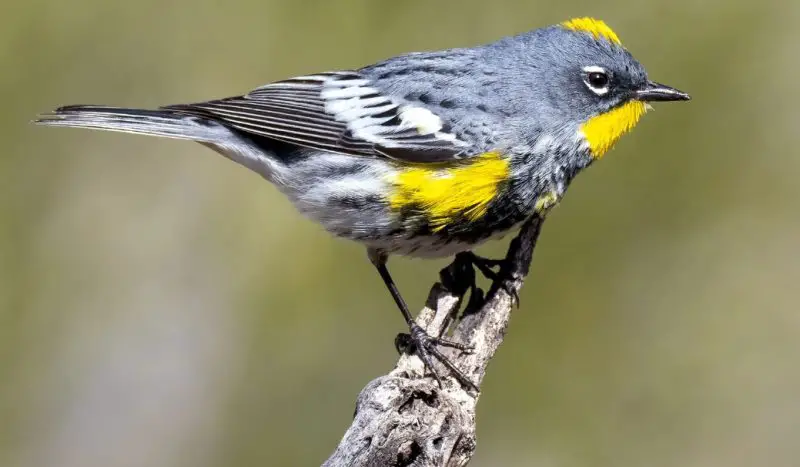
The Yellow-rumped Warbler is one of the most widespread and recognizable warblers, especially during spring and fall migration in Connecticut. It is a medium-sized warbler with gray plumage, bold black streaks, white underparts, and bright yellow patches on the rump, flanks, and crown. In winter, their coloring becomes duller and more brownish but still shows flashes of yellow.
These warblers are about 5.5 inches in length with a wingspan of 8.5 to 9 inches. Their song is a soft trill that rises slightly in pitch, and their call is a sharp “check.” They are among the few warblers that can digest waxy berries, especially those of bayberry and juniper, which allows them to overwinter farther north than most other warblers.
In Connecticut, Yellow-rumped Warblers are commonly seen during migration in April–May and again in September–October. They frequent forest edges, parks, gardens, and even coastal thickets. While not typical feeder birds, they may visit during migration if suet or mealworms are offered. Their adaptability, unique feeding habits, and eye-catching markings make them one of the most frequently observed warblers in the state.
White-throated Sparrow
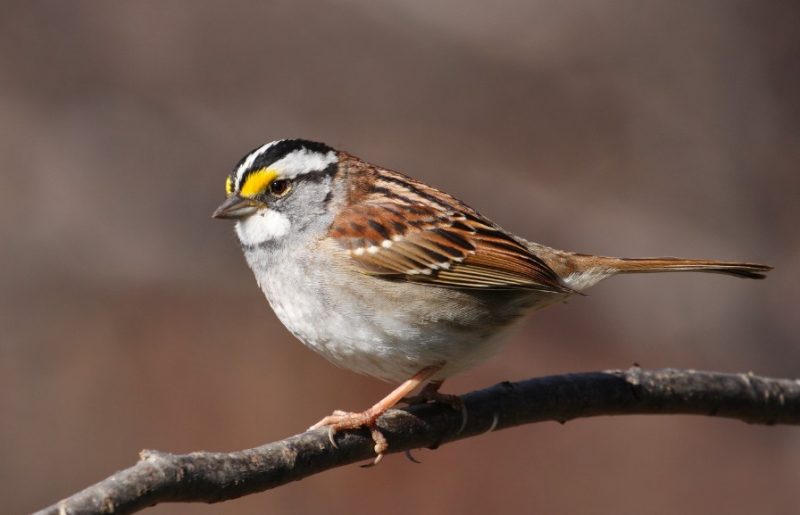
The White-throated Sparrow is easily identified by its striking white throat patch and bold black-and-white stripes on its head. Its yellow “lores” (the area between the eyes and bill) add another distinctive touch. These sparrows have a warm brown body with streaked wings and a grayish face, giving them a crisp, clean appearance.
Measuring about 6 to 7 inches long with a wingspan of 8.5 to 9.8 inches, the White-throated Sparrow is well known for its clear, melodious whistle that sounds like “Oh sweet Canada, Canada,” repeated several times. This song is often heard in the early morning or during quiet moments, making them favorites among birders in winter.
In Connecticut, White-throated Sparrows are common winter visitors, arriving in late fall and staying through early spring. They favor shrubby woodlands, forest edges, and backyard thickets where they forage on the ground for seeds and insects. Though not frequent at feeders, they will visit platforms or scatter seed beneath feeders if available. Their sweet songs and distinct markings brighten cold winter days.
Fox Sparrow
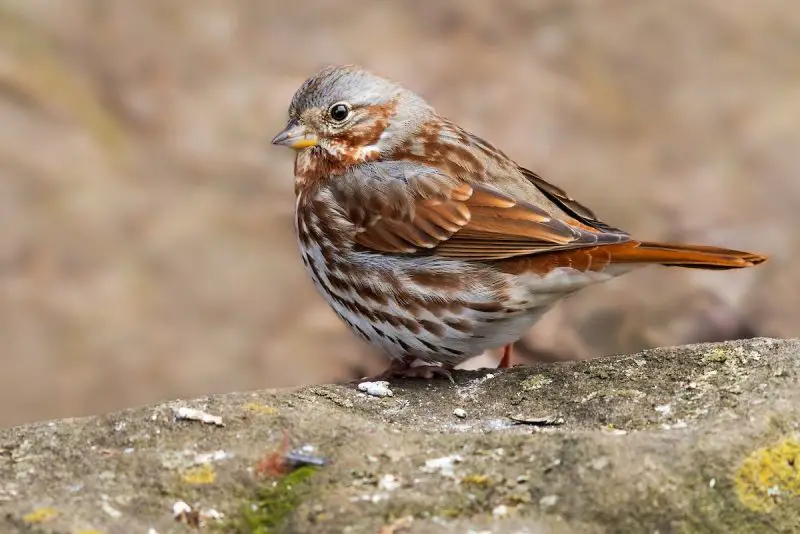
The Fox Sparrow is a large, robust sparrow with a rich reddish-brown coloration and heavily streaked chest that resembles the fur of a fox. Its chunky body and thick bill set it apart from smaller, more delicate sparrows. The bird’s warm plumage makes it a striking sight among the duller colors of winter.
Fox Sparrows measure about 7 to 8 inches in length with a wingspan of around 11 inches. They are shy and secretive, often foraging by flipping through leaf litter and dense underbrush in search of insects, seeds, and berries. Their flight is direct but usually short, preferring to stay hidden on or near the ground.
In Connecticut, Fox Sparrows are primarily winter visitors found in shrubby fields, forest edges, and overgrown thickets. They rarely visit feeders but can sometimes be enticed with scattered seed or suet in wooded yards. Their striking appearance and uncommon winter presence make them a special find for bird enthusiasts during colder months.
Golden-crowned Kinglet
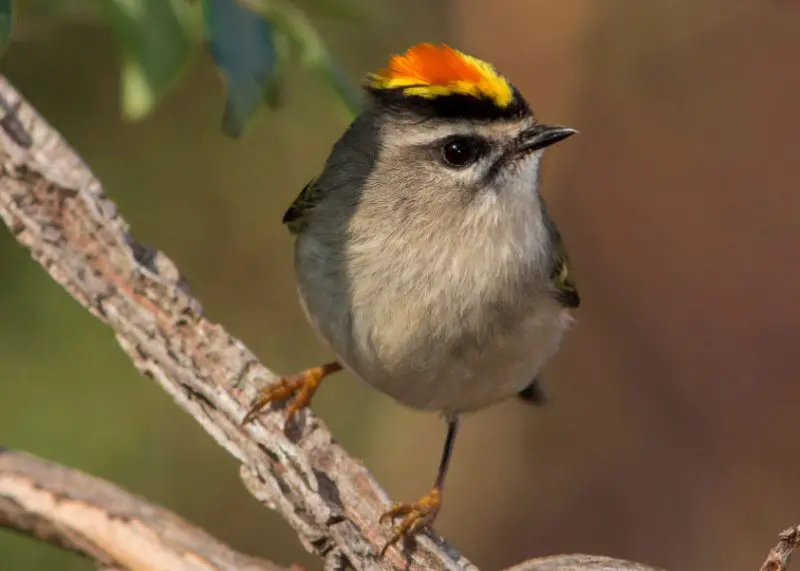
The Golden-crowned Kinglet is one of the tiniest songbirds in Connecticut, notable for its bright yellow and black crown patch contrasted against gray-green upperparts and pale underparts. This tiny bird moves quickly and constantly flicks its wings and tail, making it a lively and captivating presence.
These kinglets measure about 3.5 to 4 inches long with a wingspan of 5.9 to 7.1 inches. Their thin, high-pitched calls and rapid trills are often the first clue to their presence in dense conifers or mixed forests. Despite their small size, Golden-crowned Kinglets are hardy and can endure cold winters by fluffing up their feathers for insulation.
In Connecticut, they are mostly winter residents, frequenting coniferous forests, evergreen stands, and mixed woodlands. They rarely visit feeders but may be spotted gleaning insects from branches or exploring gardens with nearby trees. Their vibrant crown and energetic movements make them a delightful, if sometimes elusive, backyard visitor during the colder months.
Hermit Thrush
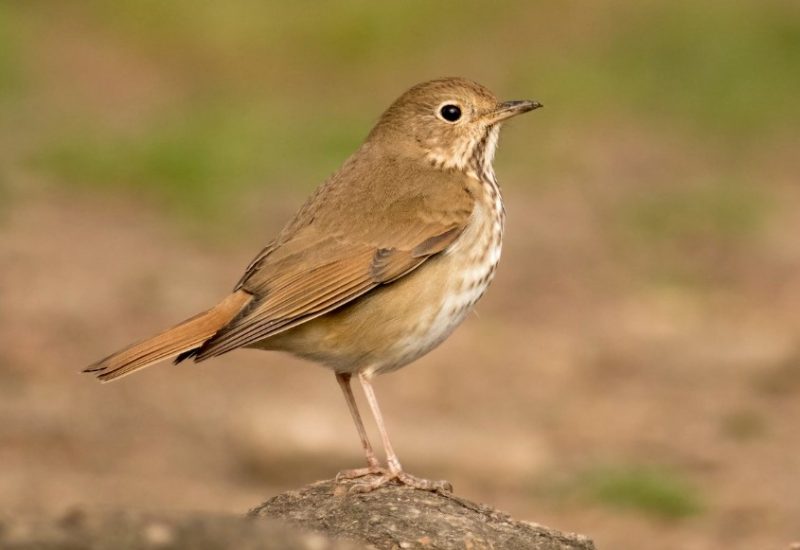
The Hermit Thrush is a medium-sized thrush with warm brown upperparts, a white belly, and bold dark spots on its chest. Its reddish tail, often flicked upward, adds a splash of color to an otherwise earthy-toned bird. Hermit Thrushes are renowned for having one of the most beautiful and haunting songs among North American birds.
Measuring about 6.3 to 7 inches long with a wingspan of 10 to 12 inches, the Hermit Thrush sings a clear, flute-like melody with rising and falling phrases that echo through quiet woodlands at dawn and dusk. Their soft calls include sharp “whit” notes and occasional trills.
In Connecticut, Hermit Thrushes breed in mature forests and woodland edges and can be found year-round in some parts of the state. They prefer shady, dense understory habitats and often forage on the forest floor for insects, berries, and fallen fruits. Their ethereal song and shy behavior make spotting them a rewarding experience for birdwatchers.
Brown Creeper
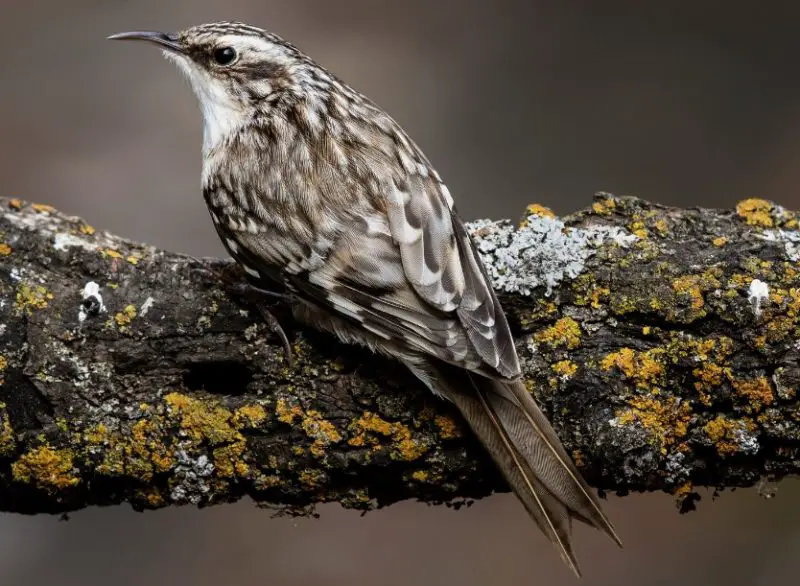
The Brown Creeper is a small, slender bird with mottled brown-gray plumage that provides excellent camouflage against tree bark. It has a thin, slightly curved bill adapted for probing crevices. Unlike nuthatches, which climb down trees headfirst, Brown Creepers always move upward as they search for insects.
Brown Creepers measure about 5 inches long with a wingspan of 7.5 to 9 inches. Their thin, high-pitched call is a soft “tsee” or “seet,” often hard to detect due to their secretive behavior. They use their stiff tail feathers for support as they spiral up trunks and large branches.
In Connecticut, Brown Creepers are primarily seen in fall and winter, favoring mature deciduous and mixed forests with plenty of old trees. They rarely visit feeders but may forage beneath suet feeders or tree bark near yards. Their cryptic coloring and unique climbing style make them a fascinating, if elusive, backyard species during colder months.
Frequently Asked Questions About Backyard Birds in Connecticut
What are the most common backyard birds in Connecticut?
Connecticut’s backyards attract a variety of birds year-round. Some of the most common species include the Northern Cardinal, American Robin, Black-capped Chickadee, Blue Jay, and Mourning Dove. These birds are frequently seen at feeders, in gardens, and around trees.
When is the best time to observe backyard birds in Connecticut?
Birdwatching is rewarding throughout the year in Connecticut, but spring and fall migrations offer the highest diversity of species. Early mornings and late afternoons are generally the best times to see active birds feeding or singing.
How can I attract more birds to my backyard in Connecticut?
To attract a wider variety of birds, provide a combination of food sources such as sunflower seeds, suet, nyjer, and mealworms. Plant native shrubs and trees that produce berries and offer shelter. Also, provide fresh water in birdbaths and avoid using pesticides.
What types of feeders work best for backyard birds in Connecticut?
Tube feeders are excellent for small songbirds like finches and chickadees. Platform feeders attract ground feeders such as sparrows and juncos. Suet feeders appeal to woodpeckers and nuthatches. Different feeder types help attract diverse species.
Which backyard birds are year-round residents in Connecticut?
Species like the Northern Cardinal, Black-capped Chickadee, Blue Jay, and Mourning Dove stay throughout the year. These birds have adapted well to Connecticut’s climate and can find food and shelter during winter months.
What should I feed backyard birds during winter in Connecticut?
High-energy foods such as black oil sunflower seeds, suet, peanuts, and dried fruit are ideal during cold months. These foods help birds maintain their energy and body heat. Also, provide unfrozen fresh water for drinking.
Are there any migratory birds that visit Connecticut backyards?
Yes, many migratory birds visit Connecticut backyards during spring and fall. Examples include the Ruby-throated Hummingbird, Baltimore Oriole, Yellow-rumped Warbler, and various warblers and sparrows. Migration seasons are great for birdwatching diversity.
How can I identify different backyard birds in Connecticut?
Pay attention to bird size, shape, coloration, markings, songs, and behaviors. Field guides, mobile apps, and online resources can help with identification. Observing birds at feeders or with binoculars also improves recognition skills.
Do backyard birds in Connecticut need water sources?
Yes, clean water sources such as birdbaths or shallow dishes are essential, especially during dry periods or winter when natural water is scarce. Moving water features like drippers or fountains can attract even more birds.
How do backyard birds in Connecticut adapt to winter?
Many birds fluff their feathers to trap heat, change their diets to available seeds or berries, and seek shelter in dense shrubs or evergreens. Some species form flocks to improve foraging efficiency and predator vigilance.

